A New Method of Tractor Engine State Identification Based on Vibration Characteristics
Abstract
:1. Introduction
2. Materials and Methods
2.1. Vibration Experiments with Tractor in Different Driving Conditions
2.1.1. Experimental Parameters
2.1.2. Experimental Site
2.1.3. Experimental Protocol
2.2. Feature Extraction and State Recognition Methods
2.2.1. Variational Mode Decomposition
- Initialize , , , to 0.
- Perform iterative update of , , by Equations (1)–(3) and stop when iteration termination condition (4) is satisfied, where ϵ > 0.
- Obtain the K modal components, where is the result of f(t), which is converted by the Fourier function; α is the penalty factor; λ is the Lagrange multiplier; and ϵ is the loop stop threshold, i.e., the allowed maximum value of the summation of error terms.
2.2.2. Permutation Entropy
- 1
- Reconstruct in phase space the computed time series x(i), i∈(1,N) and obtain a matrix:where n is the embedding dimension (i.e., the length of the intercepted sequence), τ is the delay time (i.e., the interval of sampling points), G is the number of subsequences of the vector space reconstruction, and . The subsequences are:
- 2
- Transform the obtained G subsequences into permutations by size, considering possibilities.
- 3
- Calculate the probability P of each size relationship arrangement:where c is the occurrence frequency of each permutation index.
- 4
- Calculate the information entropy of these probabilities:
- 5
- Normalize the PE:where 0 ≤ PE ≤ 1, and the PE value indicates the disorder level of time series x(i); the higher the PE value, the greater the randomness of x(i); and the smaller the PE value, the stronger the regularity of x(i).
2.2.3. Support Vector Machine
- 1
- Set the given training sample and expected output.
- 2
- Choose the kernel function K and penalty parameter C to construct the optimization problem.where the optimal solution is .
- 3
- Choose a positive component from that is less than C.
- 4
- Find the decision function.
2.2.4. Random Forest
2.3. Tractor Condition Identification Method
3. Results
3.1. State Recognition Based on SVM
3.2. State Recognition Based on Random Forest
3.3. State Recognition Based on EMD and SVM
3.4. State Recognition Based on VMD and Backpropagation
4. Discussion
Author Contributions
Funding
Institutional Review Board Statement
Informed Consent Statement
Data Availability Statement
Conflicts of Interest
References
- Martin, P.L.; Olmstead, A.L. The Agricultural Mechanization Controversy. Science 1985, 1, 601–605. [Google Scholar] [CrossRef]
- Daum, T.; Birner, R. Agricultural mechanization in Africa: Myths, realities and an emerging research agenda. Glob. Food Secur. 2020, 26, 100393. [Google Scholar] [CrossRef]
- Yang, W.X.; Zimroz, R.; Papaelias, M. Advances in Machine Condition Monitoring and Fault Diagnosis. Electronics 2022, 11, 1563. [Google Scholar] [CrossRef]
- Yule, I.J.; Kohnen, G.; Nowak, M. A tractor performance monitor with DGPS capability. Comput. Electron. Agric. 1999, 23, 155–174. [Google Scholar] [CrossRef]
- Delgado-Arredondo, P.A.; Morinigo-Sotelo, D.; Osornio-Rios, R.A.; Avina-Cervantes, J.G.; Rostro-Gonzalez, H.; Romero-Troncoso, R.J. Methodology for fault detection in induction motors via sound and vibration signals. Mech. Syst. Signal Process. 2017, 83, 568–589. [Google Scholar] [CrossRef]
- Qiang, W.; Peilin, Z.; Chen, M.; Huaiguang, W.; Cheng, W. Multi-task Bayesian compressive sensing for vibration signals in diesel engine health monitoring. Measurement 2018, 136, 625–635. [Google Scholar] [CrossRef]
- Rahman, A.; Hoque, M.E.; Rashid, F.; Alam, F.; Ahmed, M.M. Health Condition Monitoring and Control of Vibrations of a Rotating System through Vibration Analysis. J. Sens. 2022, 4281596. [Google Scholar] [CrossRef]
- Nguyen, V.N.; Matsuo, T.; Inaba, S.; Koumoto, T. Experimental analysis of vertical soil reaction and soil stress distribution under off-road tires. J. Terramech. 2008, 45, 25–44. [Google Scholar] [CrossRef]
- Hosseinpour-Zarnaq, M.; Omid, M.; Biabani-Aghdam, E. Fault diagnosis of tractor auxiliary gearbox using vibration analysis and random forest classifier. Inf. Process. Agric. 2022, 9, 60–67. [Google Scholar] [CrossRef]
- Bahrami, M.; Javadikia, H.; Ebrahimi, E. Intelligent Prediction of Fault Severity of Tractor’s Gearbox by Time-domain and Frequency-domain (FFT phase angle and PSD) Statistics Analysis and ANFIS. J. Mech. Eng. 2017, 47, 51–61. [Google Scholar] [CrossRef]
- Sun, M.L.; Lu, C.H.; Liu, Z.; Shen, C.R.; Chen, H.; Sun, Y. Response Synthesizing Based on Global Transmissibility Direct Transmissibility Method: A Case Numerical and Experimental Study. J. Vib. Eng. Technol. 2022. [Google Scholar] [CrossRef]
- Li, D.; Zheng, Y.; Zhao, W. Fault Analysis System for Agricultural Machinery Based on Big Data. IEEE Access 2019, 7, 99136–99151. [Google Scholar] [CrossRef]
- Zheng, E.; Cui, S.; Yang, Y.Z.; Xue, J.L.; Zhu, Y.; Lin, X.Z. Simulation of the Vibration Characteristics for Agricultural Wheeled Tractor with Implement and Front Axle Hydropneumatic Suspension. Shock. Vib. 2019, 2019, 9135412. [Google Scholar] [CrossRef]
- Deboli, R.; Calvo, A.; Preti, C. Whole-body vibration: Measurement of horizontal and vertical transmissibility of an agricultural tractor seat. Int. J. Ind. Ergon. 2017, 58, 69–78. [Google Scholar] [CrossRef]
- Hajnayeb, A.; Fernando, J.S.; Sun, Q. Effects of vehicle driveline parameters and clutch judder on gearbox vibrations. Proc. Inst. Mech. Eng. Part D J. Automob. Eng. 2021, 236, 84–98. [Google Scholar] [CrossRef]
- Chen, P.S.; Xu, L.Y.; Tang, Q.S.; Shang, L.L.; Liu, W. Research on prediction model of tractor sound quality based on genetic algorithm. Appl. Acoust. 2022, 185, 108411. [Google Scholar] [CrossRef]
- Migal, V.; Arahun, S.; Shuliak, M.; Huatov, A.; Trunova, I.; Shevchenko, I. Assessing design and manufacturing quality of tractor gearboxes by their vibration characteristics. J. Vib. Control 2022, 1–11. [Google Scholar] [CrossRef]
- Phromjan, J.; Suvanjumrat, C. Vibration effect of two different tires on baggage towing tractors. J. Mech. Sci. Technol. 2018, 32, 1539–1548. [Google Scholar] [CrossRef]
- Liu, C.; Cheng, G.; Chen, X.H.; Pang, Y.S. Planetary gears feature extraction and fault diagnosis method based on VMD and CNN. Sensors 2018, 18, 1523. [Google Scholar] [CrossRef] [Green Version]
- Dragomiretskiy, K.; Zosso, D. Variational Mode Decomposition. IEEE Trans. Signal Process. 2014, 62, 531–545. [Google Scholar] [CrossRef]
- Chen, S.Q.; Yang, Y.; Dong, X.J.; Xing, G.P.; Peng, Z.K.; Zhang, W.M. Warped Variational Mode Decomposition With Application to Vibration Signals of Varying-Speed Rotating Machineries. IEEE Trans. Instrum. Meas. 2019, 68, 2755–2767. [Google Scholar] [CrossRef]
- Miao, Y.H.; Zhang, B.Y.; Li, C.H.; Lin, J.; Zhang, D.Y. Feature Mode Decomposition: New Decomposition Theory for Rotating Machinery Fault Diagnosis. IEEE Trans. Ind. Electron. 2023, 70, 1949–1960. [Google Scholar] [CrossRef]
- Wang, X.B.; Yang, Z.X.; Yan, X.A. Novel Particle Swarm Optimization-Based Variational Mode Decomposition Method for the Fault Diagnosis of Complex Rotating Machinery. IEEE/ASME Trans. Mechatron. 2018, 23, 68–79. [Google Scholar] [CrossRef]
- Feng, Z.P.; Zhang, D.; Zuo, M.J. Adaptive Mode Decomposition Methods and Their Applications in Signal Analysis for Machinery Fault Diagnosis: A Review With Examples. IEEE Access 2017, 5, 24301–24331. [Google Scholar] [CrossRef]
- Cao, P.P.; Wang, H.L.; Zhou, K.J. Multichannel Signal Denoising Using Multivariate Variational Mode Decomposition With Subspace Projection. IEEE Access 2020, 8, 74039–74047. [Google Scholar] [CrossRef]
- Zhang, C.; Zhang, Y.B.; Hu, C.X.; Liu, Z.B.; Cheng, L.Y.; Zhou, Y. A Novel Intelligent Fault Diagnosis Method Based on Variational Mode Decomposition and Ensemble Deep Belief Network. IEEE Access 2020, 8, 36293–36312. [Google Scholar] [CrossRef]
- Cheng, Y.S.; Li, X.Q.; Sun, S.S. A new method for expression and classification of long wave road surface unevenness in field. J. Vib. Shock. 2022, 41, 180–188. [Google Scholar]
- Cheng, Y.S.; Li, X.Q.; Man, X.L.; Fan, F.F.; Li, Z.X. Perceiving Excitation Characteristics from Interactions between Field Road and Vehicle via Vibration Sensing. Hindawi 2021, 5548725. [Google Scholar] [CrossRef]
- Bandt, C.; Pompe, B. Permutation entropy: A natural complexity measure for time series. Phys. Rev. Lett. 2002, 88, 174102. [Google Scholar] [CrossRef]
- Guo, Y.F.; Zhang, Z.S. Generalized Variational Mode Decomposition: A Multiscale and Fixed-Frequency Decomposition Algorithm. IEEE Trans. Instrum. Meas. 2021, 70, 1–13. [Google Scholar] [CrossRef]
- Chen, X.J.; Yang, Y.M.; Cui, Z.X.; Shen, J. Wavelet Denoising for the Vibration Signals of Wind Turbines Based on Variational Mode Decomposition and Multiscale Permutation Entropy. IEEE Access 2020, 8, 40347–40356. [Google Scholar] [CrossRef]
- Cortes, C.; Vapnik, V. Support-Vector Networks. Mach. Learn. 1995, 20, 273–297. [Google Scholar] [CrossRef]
- Breiman, L. Random Forests. Mach. Learn. 2001, 45, 5–32. [Google Scholar] [CrossRef] [Green Version]
- Cao, Y.H.; Tung, W.W.; Gao, J.B.; Protopopescu, V.A.; Hively, L.M. Detecting dynamical changes in time series using the permutation. Phys. Rev. E 2004, 70, 046217. [Google Scholar] [CrossRef] [PubMed]

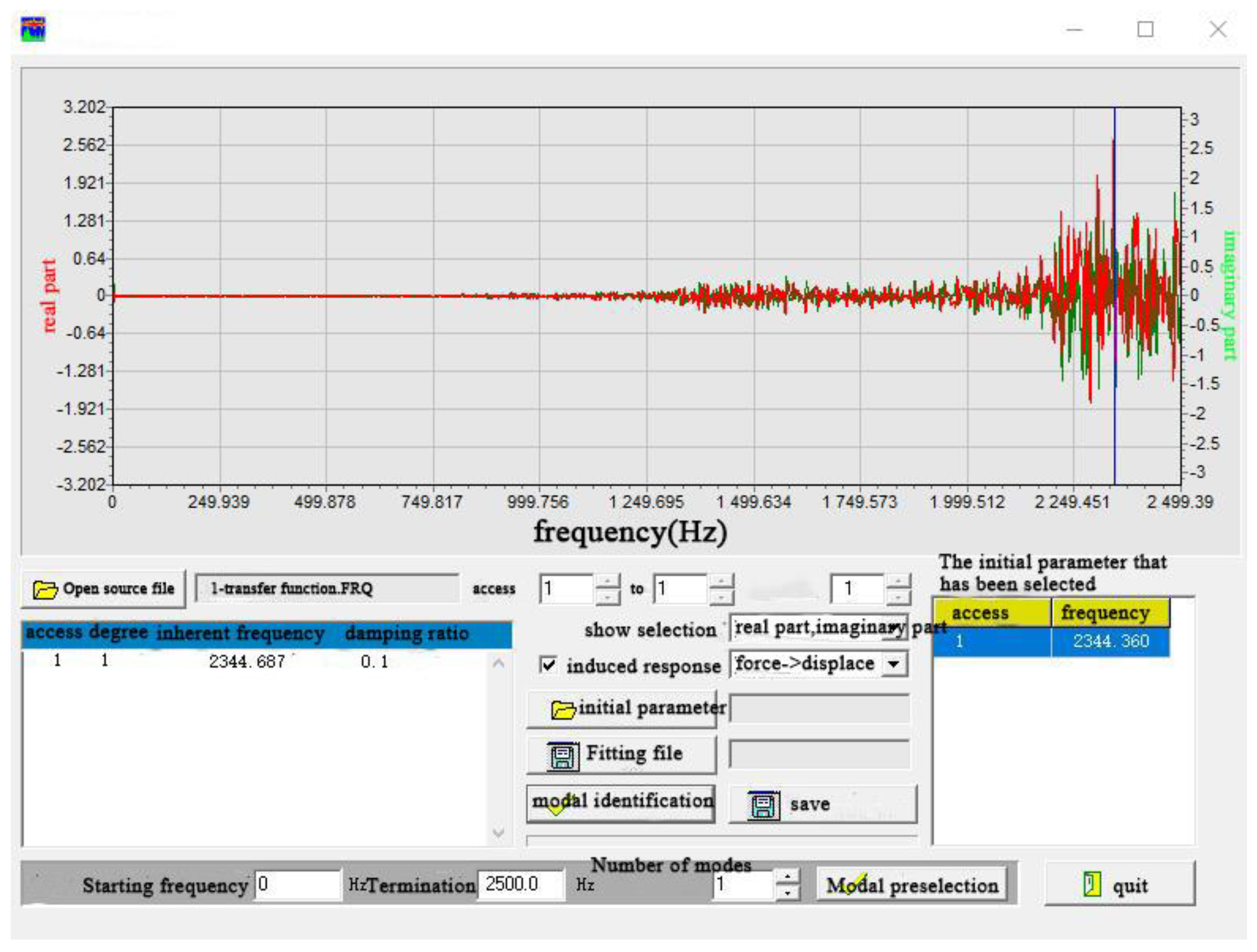


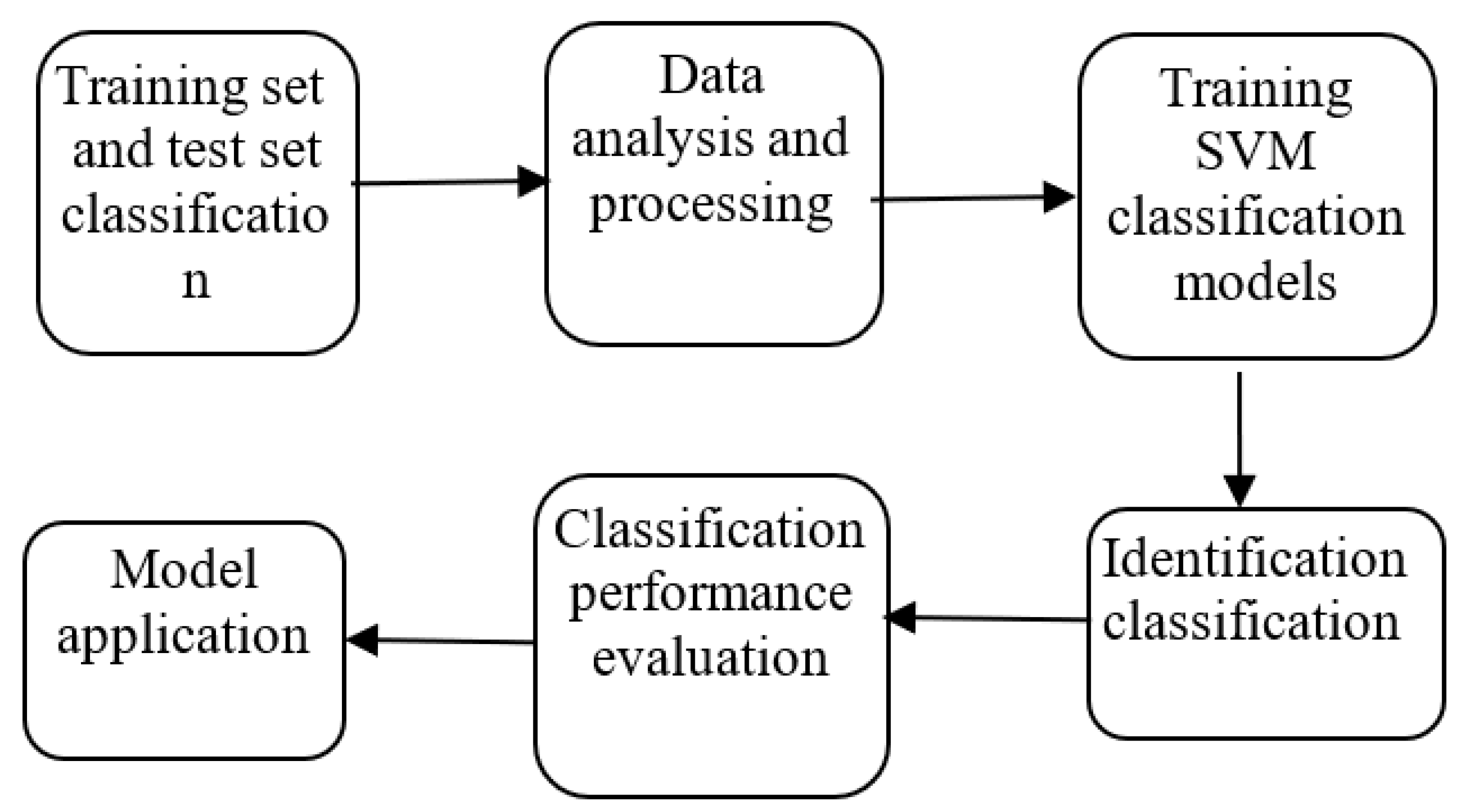
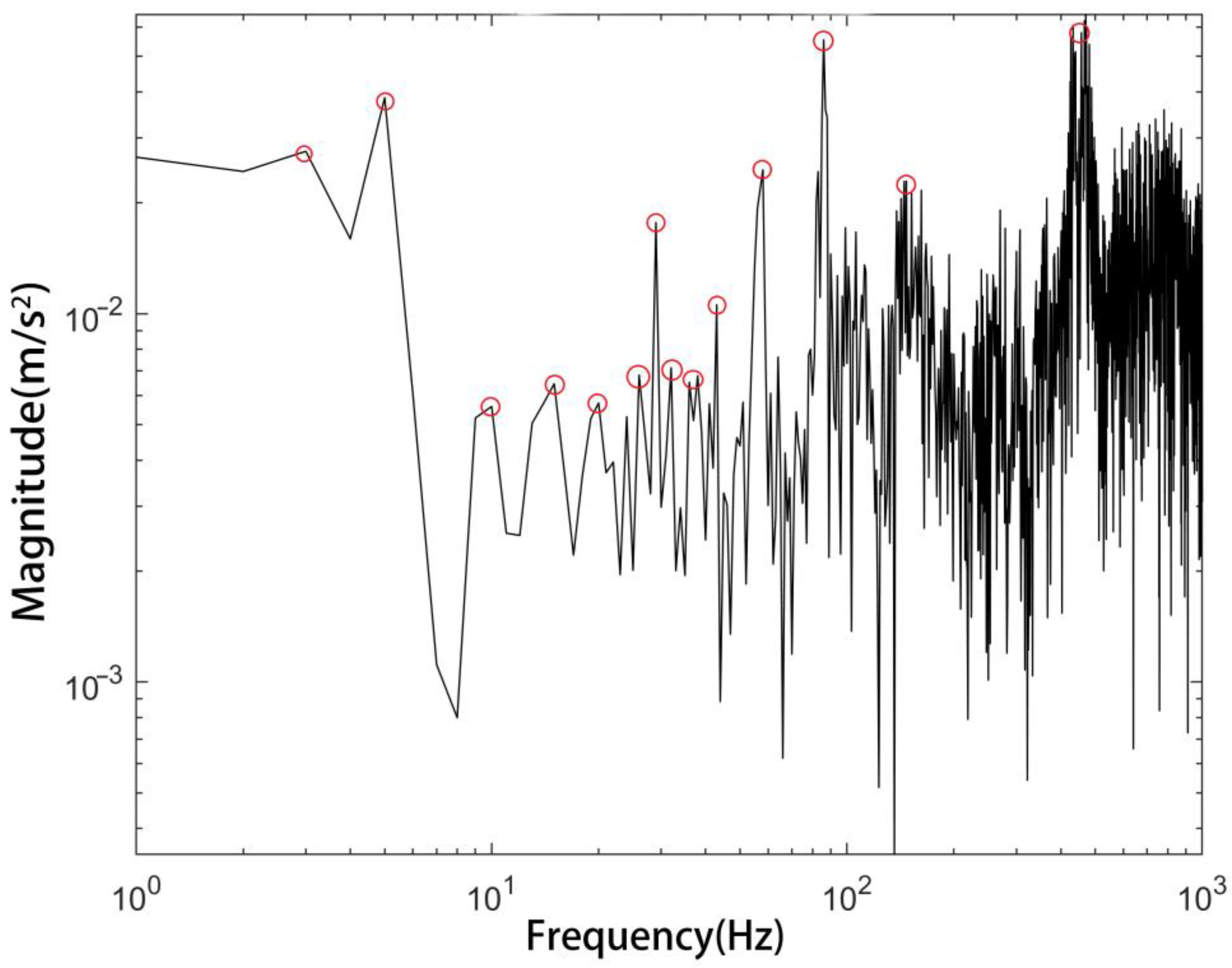
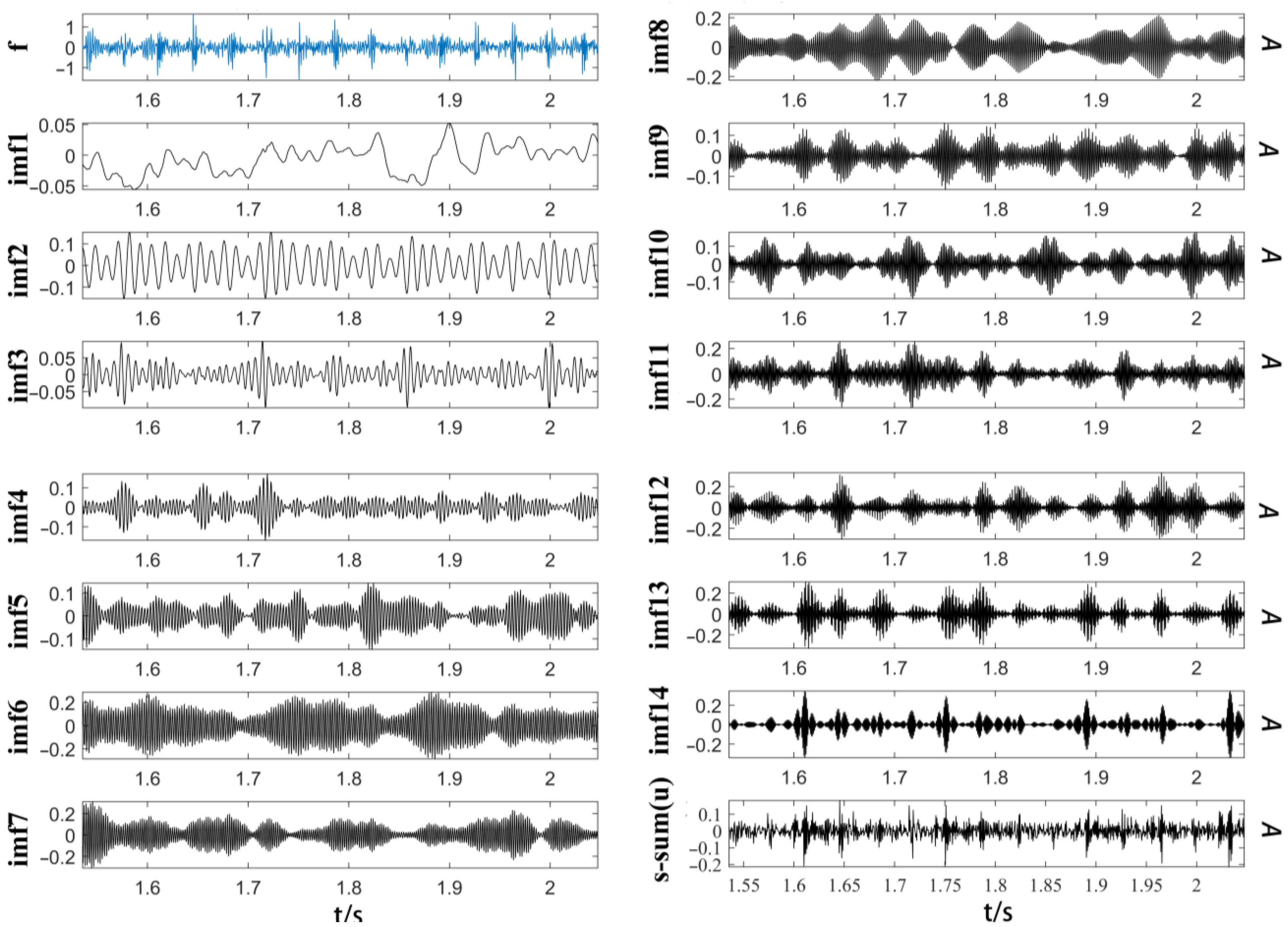


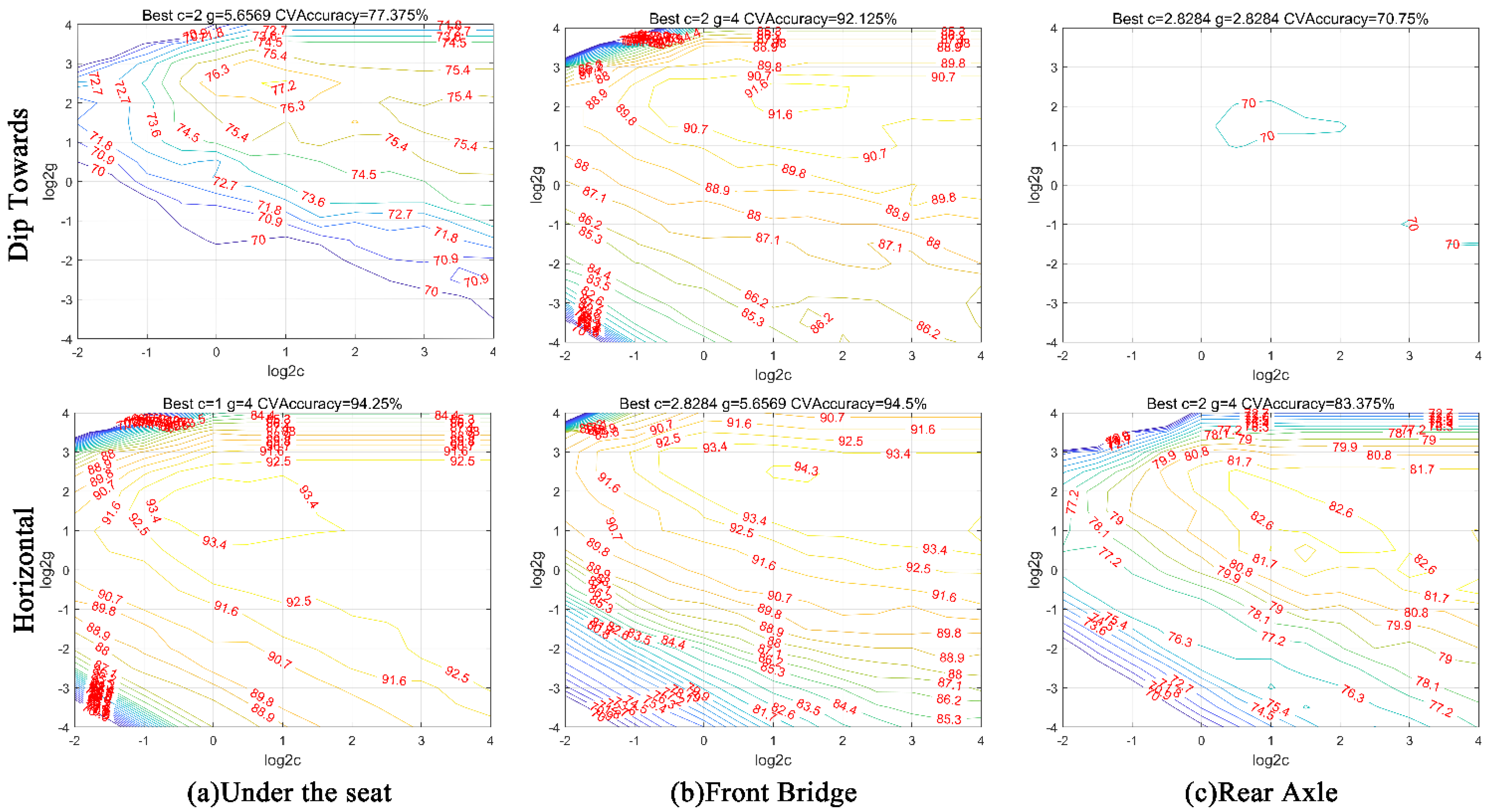
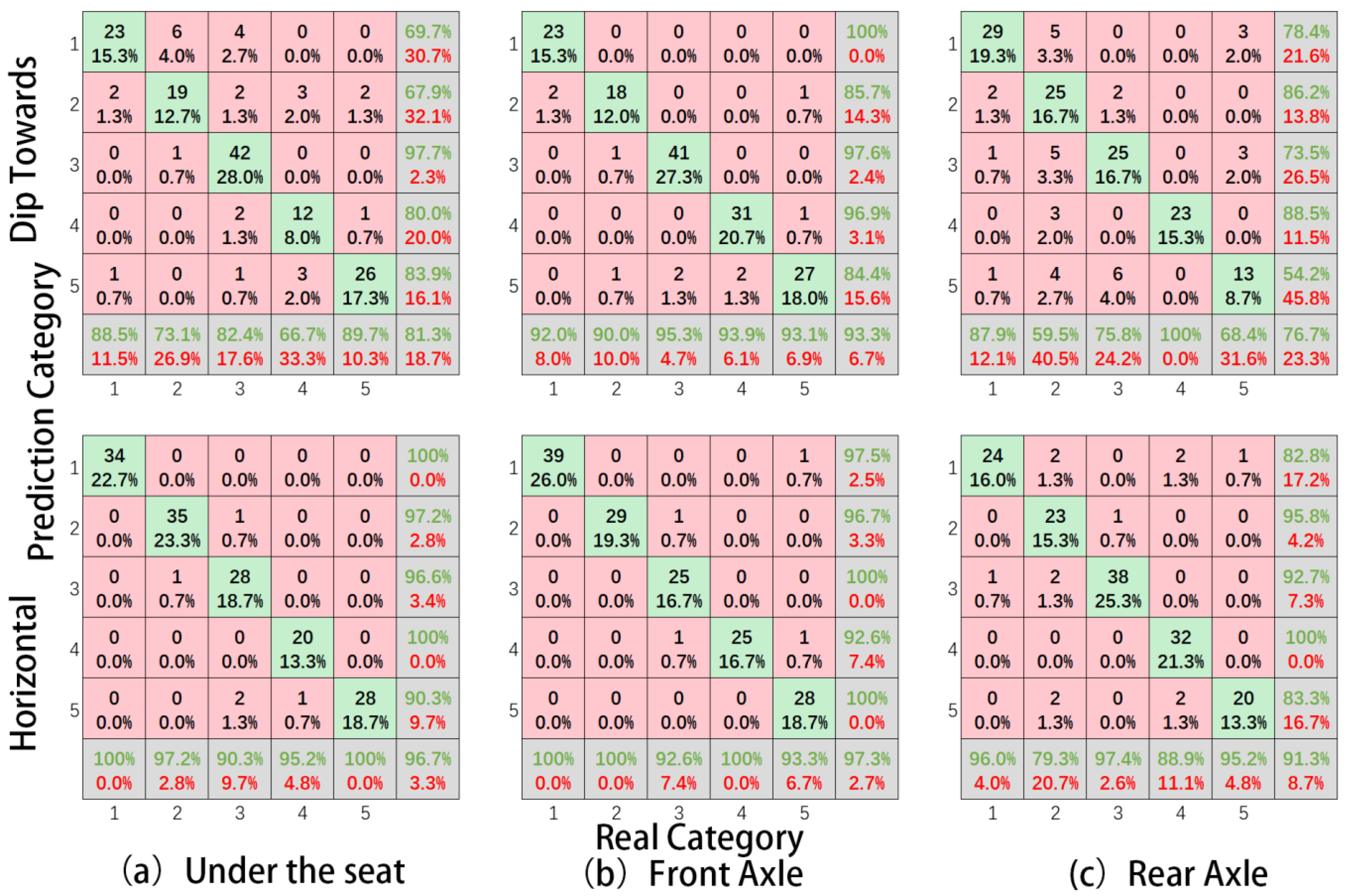
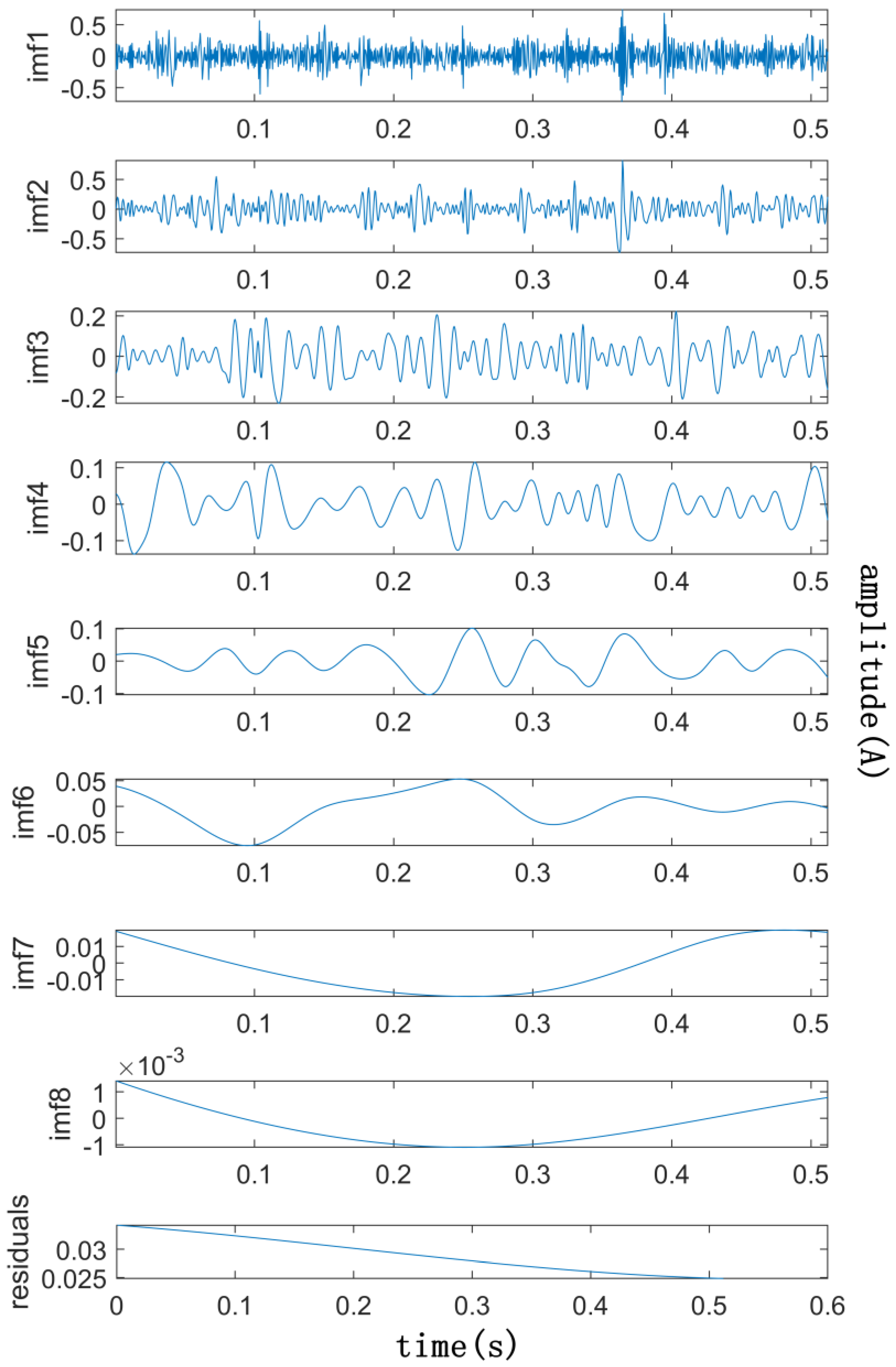
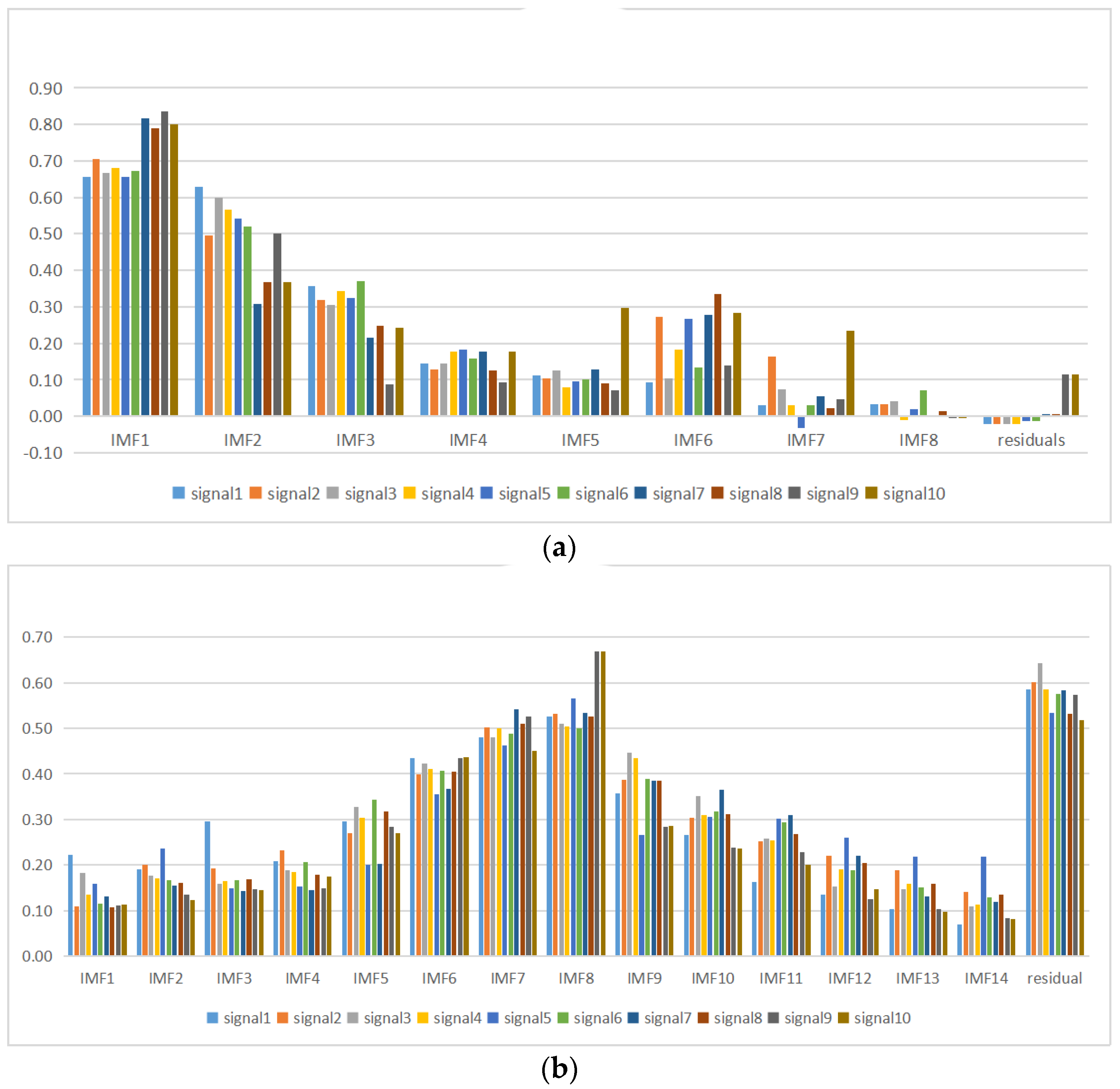
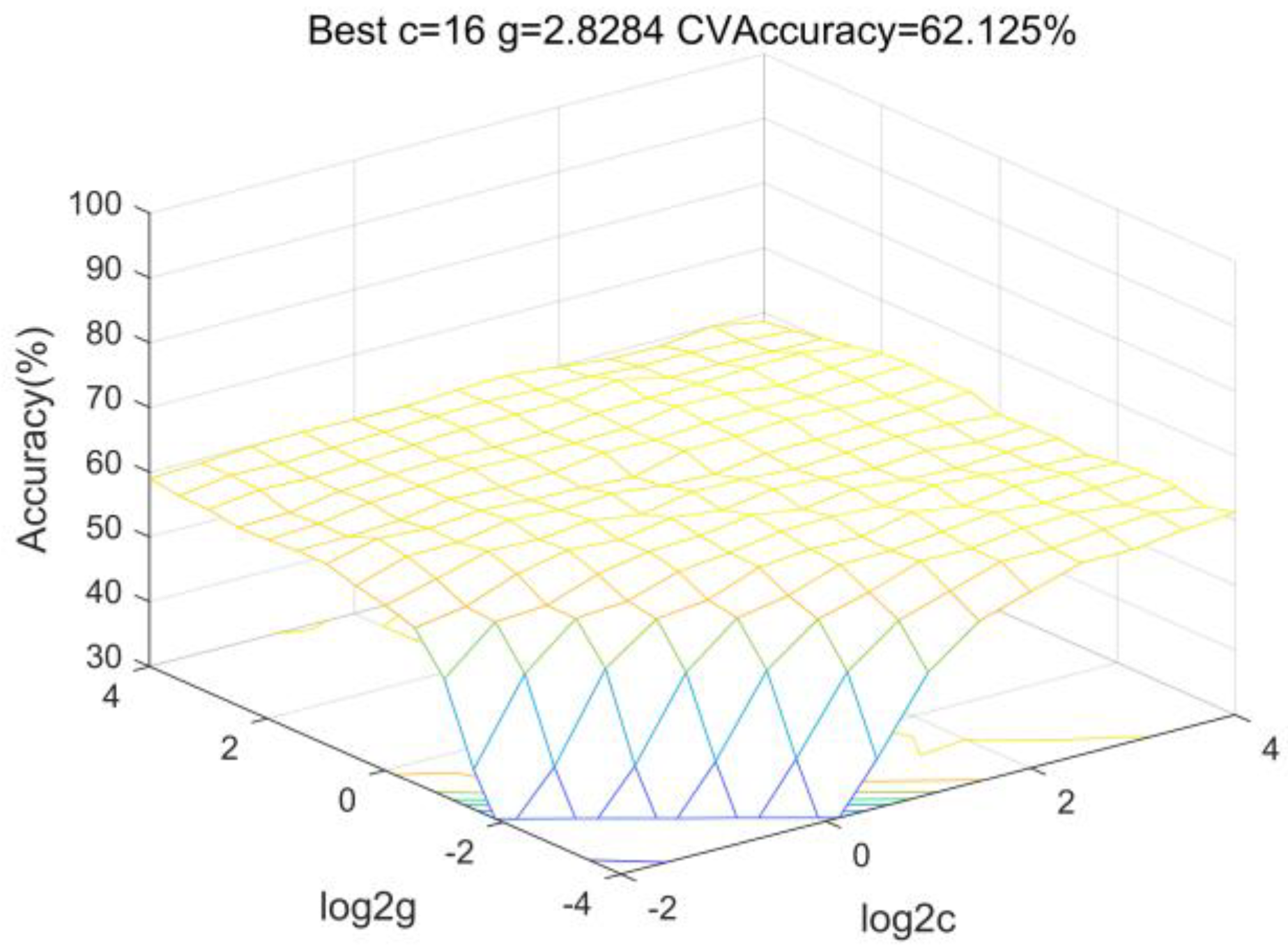

| Parameter | Data |
|---|---|
| Weight | 3488 kg |
| Length | 4.372 m |
| Standard tire pressure for front wheels | 240 kPa |
| Front wheelbase | 1.556–1.845 m |
| Rear wheel standard tire pressure | 200 kPa |
| Rear wheelbase | 1.512–1.851 m |
| Engine rated speed | 2300 r/min |
| Tractor wheelbase | 2.23 m |
| Instrument | Model |
|---|---|
| Virtual instruments | VibeSys |
| Acceleration sensor | BZ1123 |
| Integral amplifier | WS-2401 |
| Data collector | WS-5291 |
| Computers | Windows v1.02 |
| Vehicle-mounted correction inverter | TX-1000VA |
| Portable battery | 4 × 12 v |
| Sampling rate | 2000 Hz |
| K | N | Center Frequency of Each Mode (Hz) | ||||||||||||||||
|---|---|---|---|---|---|---|---|---|---|---|---|---|---|---|---|---|---|---|
| 1 | 17 | 92 | ||||||||||||||||
| 2 | 18 | 90 | 458 | |||||||||||||||
| 3 | 86 | 90 | 457 | 792 | ||||||||||||||
| 4 | 111 | 90 | 433 | 474 | 794 | |||||||||||||
| 5 | 61 | 82 | 157 | 457 | 666 | 815 | ||||||||||||
| 6 | 107 | 7 | 94 | 432 | 473 | 671 | 817 | |||||||||||
| 7 | 115 | 7 | 94 | 432 | 473 | 654 | 770 | 858 | ||||||||||
| 8 | 54 | 6 | 92 | 265 | 433 | 473 | 654 | 771 | 858 | |||||||||
| 9 | 130 | 6 | 92 | 264 | 432 | 472 | 600 | 695 | 786 | 866 | ||||||||
| 10 | 169 | 5 | 86 | 156 | 355 | 434 | 472 | 602 | 697 | 787 | 867 | |||||||
| 11 | 152 | 5 | 86 | 154 | 285 | 433 | 472 | 594 | 681 | 774 | 849 | 948 | ||||||
| 12 | 107 | 5 | 86 | 153 | 264 | 365 | 434 | 472 | 596 | 683 | 775 | 849 | 948 | |||||
| 13 | 93 | 5 | 86 | 153 | 264 | 364 | 434 | 472 | 584 | 658 | 722 | 791 | 856 | 952 | ||||
| 14 | 146 | 5 | 86 | 153 | 263 | 362 | 433 | 466 | 495 | 591 | 660 | 724 | 792 | 857 | 952 | |||
| 15 | 436 | 5 | 86 | 153 | 263 | 362 | 433 | 466 | 494 | 589 | 657 | 713 | 770 | 817 | 868 | 957 | ||
| 16 | 500 | 5 | 86 | 153 | 261 | 355 | 416 | 437 | 467 | 497 | 590 | 657 | 714 | 770 | 817 | 868 | 957 | |
| K | 1 | 2 | 3 | 4 | 5 | 6 | 7 | 8 | 9 | 10 | 11 | 12 | 13 | 14 | More than One Item | |
|---|---|---|---|---|---|---|---|---|---|---|---|---|---|---|---|---|
| S1 | 30 | 36 | 37 | 42 | 34 | 25 | 23 | 22 | 22 | 25 | 25 | 28 | 31 | 31 | 70 | |
| S2 | 14 | 17 | 17 | 18 | 28 | 41 | 49 | 55 | 36 | 30 | 25 | 18 | 15 | 12 | 57 | 10–20 |
| S3 | 35 | 23 | 20 | 21 | 19 | 21 | 20 | 21 | 25 | 35 | 42 | 44 | 32 | 31 | 63 | 20–30 |
| S4 | 31 | 31 | 39 | 49 | 43 | 33 | 28 | 21 | 19 | 20 | 21 | 23 | 20 | 22 | 65 | 30–40 |
| S5 | 44 | 20 | 18 | 23 | 29 | 21 | 18 | 25 | 42 | 37 | 32 | 32 | 29 | 21 | 58 | 40–50 |
| S6 | 37 | 28 | 24 | 18 | 27 | 31 | 39 | 47 | 40 | 18 | 19 | 21 | 17 | 11 | 52 | >50 |
| Direction | Seats | Front Bridge | Rear Axle | Average Value |
|---|---|---|---|---|
| Vertical | 82.66 | 95.33 | 75.33 | 84.44 |
| Crosswise | 97.33 | 96.66 | 88 | 93.99 |
| Average value | 89.99 | 95.99 | 81.66 |
| Direction | Seats | Front Bridge | Rear Axle | Average Value |
|---|---|---|---|---|
| Vertical | 81.33 | 93.33 | 76.67 | 83.77 |
| Crosswise | 96.67 | 97.33 | 91.33 | 95.11 |
| Average value | 89 | 95.33 | 84 |
| Direction | Seats | Front Bridge | Rear Axle | Average Value |
|---|---|---|---|---|
| Vertical | 67.33 | 84.67 | 60.00 | 70.66 |
| Crosswise | 83.33 | 82.67 | 74.67 | 80.22 |
| Average value | 75.33 | 83.67 | 67.33 |
Disclaimer/Publisher’s Note: The statements, opinions and data contained in all publications are solely those of the individual author(s) and contributor(s) and not of MDPI and/or the editor(s). MDPI and/or the editor(s) disclaim responsibility for any injury to people or property resulting from any ideas, methods, instructions or products referred to in the content. |
© 2023 by the authors. Licensee MDPI, Basel, Switzerland. This article is an open access article distributed under the terms and conditions of the Creative Commons Attribution (CC BY) license (https://creativecommons.org/licenses/by/4.0/).
Share and Cite
Li, J.; Li, X.; Li, Y.; Zhang, Y.; Yang, X.; Xu, P. A New Method of Tractor Engine State Identification Based on Vibration Characteristics. Processes 2023, 11, 303. https://doi.org/10.3390/pr11020303
Li J, Li X, Li Y, Zhang Y, Yang X, Xu P. A New Method of Tractor Engine State Identification Based on Vibration Characteristics. Processes. 2023; 11(2):303. https://doi.org/10.3390/pr11020303
Chicago/Turabian StyleLi, Jingyao, Xiaoqin Li, Yadong Li, Yuxiangmeng Zhang, Xiangkui Yang, and Pengxiang Xu. 2023. "A New Method of Tractor Engine State Identification Based on Vibration Characteristics" Processes 11, no. 2: 303. https://doi.org/10.3390/pr11020303





